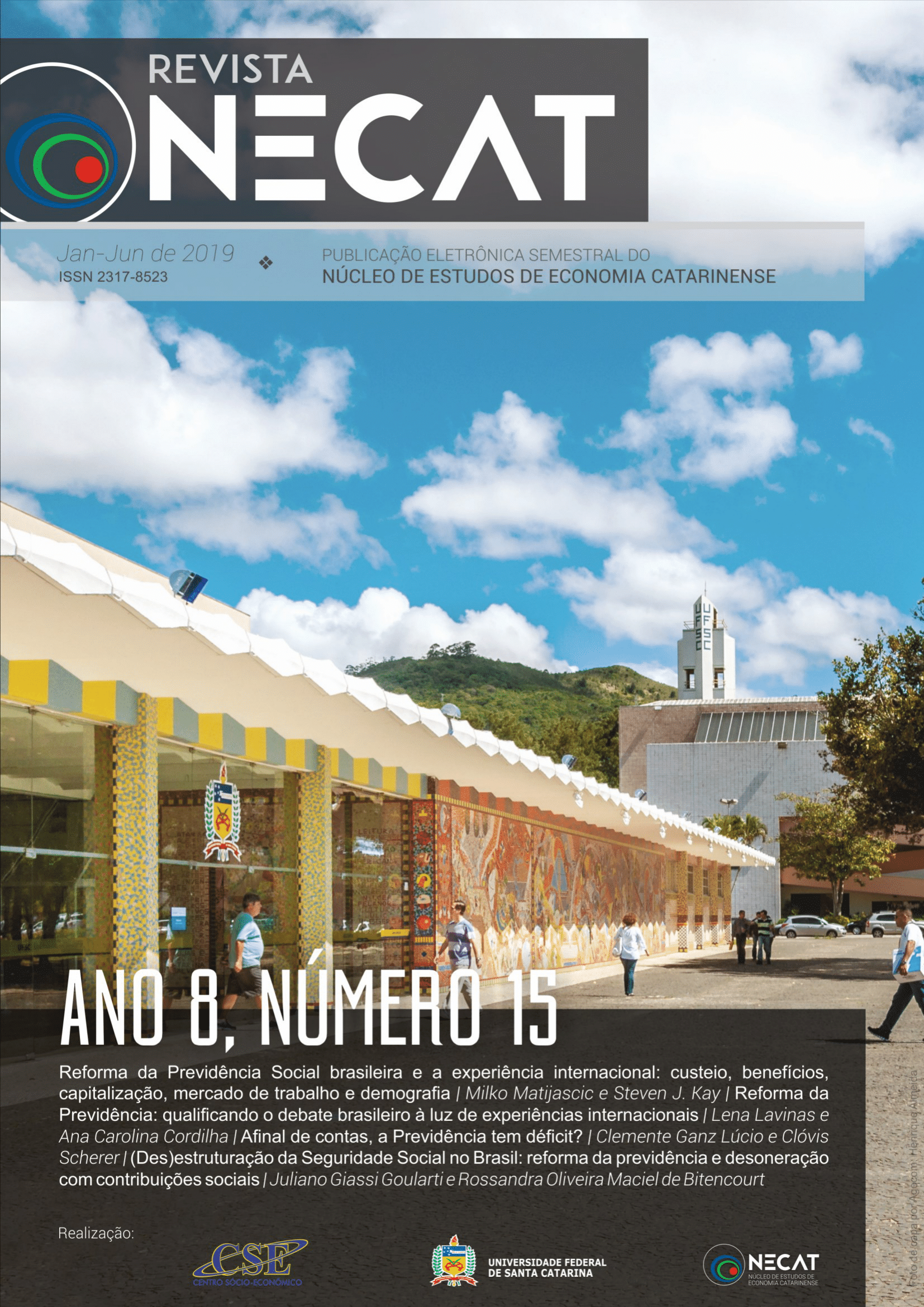Reforma da Previdência social brasileira e a experiência internacional: Custeio, benefícios, capitalização, mercado de trabalho e demografia
Palavras-chave:
Reforma da Previdência, política social comparada, mercado de trabalho.Resumo
Para analisar as questões que envolvem o debate referente à reforma da previdência brasileira prevista pela PEC-6, as seções do artigo em tela: apresentam as propostas de reforma do Presidente Jair Bolsonaro, analisam os parâmetros da previdência brasileira, comparando-os aos da experiência internacional; sintetizar os resultados das reformas baseadas na capitalização individual adotadas nos anos 1980 e 1990; destaca os limites impostos pelos mercados de trabalho nos países não desenvolvidos e seus impactos sobre a previdência e o contexto demográfico.Referências
CONSEJO ASESOR PRESIDENCIAL PARA LA REFORMA PREVISIONAl. 2006. El derecho a una vida digna en la vejez: hacia un contrato social con la prevision en Chile. Santiago: Presidencia de la República de Chile.
COSTANZI, R.; ANSILIERO, G.; SIDONI, O. Relação entre valor dos benefícios previdenciários e massa salarial dos trabalhadores ocupados: implicações para a sustentabilidade previdenciária. Nota Técnica 31, Brasília, IPEA, 2016.
DIARIO DE SESIONES DE LA CAMARA DE SENADORES. Tomo 368, Primer Periodo de la XLIV Legislatura, 1995.
ÉGERT; BALÁZA. The Impact of Changes in Second Pension Pillars on Public Finances in Central and Eastern Europe, OECD Economics Deparment Working Papers, No. 942 OECD, 2012. Disponível em: . Acesso em: 14 jun. 2019.
FAO (Food and Agriculture Organization). FAO Statistical Yearbooks 2015. World food and agriculture. Roma: FAO, 2015.
FULTZ, Elaine. The Retrenchment of Second-tier Pensions in Hungary and Poland: A Precautionary Tale. In: International Social Security Review, v. 65, n. 3, 2012.
GILL, I., PACKARD, T.; YERMO, J. Keeping the Old-Age Promise. Washington DC: Standford University Press and The Worldbank, 2005.
GILLION, C.; TURNER, J.; BAILEY, C.; LATULIPPE, D. Social security pensions: development and reform. Geneva: ILO, 2000.
HOLZMANN, R.; HINZ; R. Old-Age Income Support in the 21st Century: The World Bank’s Perspective on Pension Systems and Reform. Washington DC: The World Bank, 2006.
IEG – INDEPENDENT EVALUATION GROUP. Bank Assistance to Pension Reform and the Development of Pension Systems. Washington: Banco Mundial. 5 de Janeiro de 2006. World Bank, (Working Paper), 2006.
ILO (International Labour Office). Domestic workers across the world: global and regional statistics and the extent of legal protection. Geneva: ILO, 2013.
___________________. World social protection Report 2014/15: Building economic recovery, inclusive development and social justice – Geneva: ILO, 2015.
MATIJASCIC, M.; KAY, S. A reforma da previdência brasileira no âmbito de um mercado de trabalho heterogêneo. In: Revista da ABET, v. 16, n. 1, p. 46-65, jan-jun/ 2017.
____________________. The Brazilian Pension Model: The Pending Agenda (January March 2014). International Social Security Review, Vol. 67, Issue 3-4, pp. 71-93, 2014b.
____________________. Universal social security coverage and democracy: The Brazilian path to nation building. In Social security coverage extension in the BRICS. Geneva: ISSA, 2013
____________________. Pensions in Brazil: Reaching the limits of parametric reform. In: KAY, S.; SINHA, T. (Eds.). Lessons from pension reform in the Americas. Oxford, Oxford University Press, 2008.
____________________. Social security at the crossroads: Toward Effective Pension Reform In Latin America. In: International social security review (Print), 2006.
MITCHELL, Olivia. Epilogue: The Future of Retirement Systems in the Americas. In: KAY, S.; SINHA, T. (Eds.). Lessons from pension reform in the Americas. Oxford, Oxford University Press, 2008.
____________. Pension Privatization: Evolution of a Paradigm. In: Governance: An International Journal of Policy, Administration, and Institutions, 2013.
ORSZAG, P.; STIGLITZ, J. Rethinking Pension Reform: Ten Myths about Social Security Systems. Presented at the conference in: New Ideas About Old Age Security, World Bank, Washington, D.C. September 14, 1999.
ORTIZ, I; DURÁN-VALVERDE, F; URBAN, S; WODSAK, V.; YU, Z. La reversión de la privatización de las pensiones (2000-2018). In: ESS ─ Documento de trabajo núm. 63. Genebra: ILO, 2019.
PIERSON, Paul. Coping with permanent austerity: welfare state restructuring in affluent democracies. In: PIERSON, P. (ed.) The new politics of the Welfare State. Oxford: Oxford University Press, 2000.
PIÑERA, José. El Cascabel al Gato: La Batalla por la Reforma Previsional. Santiago: Editora Zig-Zag, 1992.
POLISH NEWS BULLETIN.Government’s Fulfilling Prophecy Bound to Crush OFE. April 11, 2014.
ROMO, S. 2014. “Pensiones: Bachelet anuncia grupo de expertos y pide ‘propuesta contundente’”. La Nación, April 29.
SOKHEY, Sarah Wilson. Russian Reversal of Privatization. Presented at: American Political Science Association Meeting, Washington DC, 2014.
STIGLITZ, J. E.; ORSZAG, P. R. Rethinking Pension Reform: Ten Myths about Social Security Systems. 1999.
WHITEFORD, P. Welfare State reform in continental and southern Europe: an overview of challenges and strategies. In: Revue Française des Affaires Sociales, n. 1, Paris, Jan-Mar, 2006.
Downloads
Publicado
Edição
Seção
Licença
Os autores manterão seus direitos autorais e concedem à revista apenas o direito de primeira publicação. O artigo será simultaneamente licenciado sob a Creative Commons Attribution License, permitindo seu compartilhamento com o devido reconhecimento de autoria e publicação inicial para esta revista.
Os autores ficam autorizados à assumir contratos adicionais, separadamente, visando distribuição não-exclusiva da versão publicada nesta revista (ex.: repositório (site)institucional, ou capítulo de livro), reconhecida a autoria e publicação inicial nesta revista.


